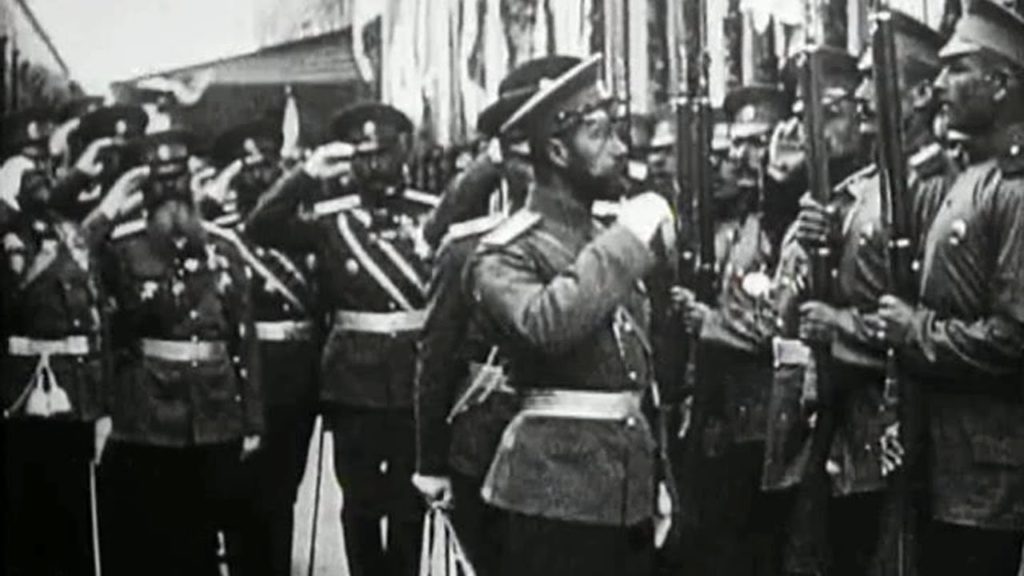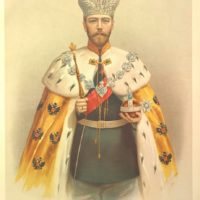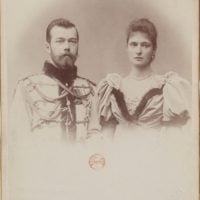
Related

Tsar Nicholas II of Russia - Emperor of Russia Nikolay II

Romanovs. Tsar Nicholas II & Raymond Poincaré

Romanovs. Czar Nicholas II & Children

Emperor of Russia Nikolay II - Public domain portrait photograph

Emperor of Russia Nikolay II - Public domain portrait print

Emperor Nicholas II and Empress Alexandra Feodorovna with military

Nicholas II Alexandrovich - Russian Emperors and Empresses

Emperor of Russia Nikolay II - Public domain portrait photograph

Emperor of Russia Nikolay II - Public domain portrait print
Romanovs. Tsar Nicholas II & The Russian Army
Summary
In this footage from the Russian State Documentary Film & Photo Archive at Krasnogorsk (RGAKFD) you can see the Russian Czar Nicholas II with the Imperial Russian Army as he reviews the troops; talks to the Russian soldiers, officers and generals; leads the Russian forces during the World War I, and participates in many other military events.
На этих кадрах кинохроники из Российского государственного архива кинофотодокументов (РГАКФД) Государь Николай II запечатлен вместе с Российской Императорской Армией: Всероссийский Император принимает военные парады; разговаривает с русскими солдатами, офицерами и генералами; возглавляет свои войска во время Первой мировой войны и участвует в разного рода военных событиях.
Soundtrack / Музыка:
1) Грузинский марш (с 0:03);
2) Егерский марш (с 2:39);
3) Марш Лейб–Гвардии Семеновского полка (с 4:51);
4) марш Лейб–Гвардии Атаманского полка (с 8:17);
5) «Взвейтесь, соколы, орлами!» (солдатская песня — с 10:40);
6) Марш Павловского военного училища (с 14:18);
7) Марш Лейб–Гвардии Волынского полка (с 16:20);
8) Марш Лейб–Гвардии Конно–Гренадерского полка (с 18:19);
9) «Эй, донцы–молодцы!» (русская народная песня времен Отечественной войны 1812 г. — с 20:06);
10) Марш Лейб–Гвардии Павловского полка (с 23:53);
11) Гимн 10–го уланского Одесского полка (с 28:46);
12) «Наполеон–то, Наполеон» (русская народная песня времен Отечественной войны 1812 г. — с 31:28)
13) «Славим Платова–героя!» (русская народная песня времен Отечественной войны 1812 г. — с 33:45)
14) Песня Лейб–Гвардии Преображенского полка (с 35:59);
15) Песня 12–й кавалерийской дивизии (с 38:26);
16) Гимн Всевеликого войска Донского (с 41:00);
17) Песня 12–го драгунского Стародубовского полка (с 44:41);
18) «Ночь темна была» (русская народная песня времен Отечественной войны 1812 г. — с 47:52);
19) Гимн Черных гусар (с 53:19);
20) Песнь о Вещем Олеге (солдатская песня по одноименному произведению А. С. Пушкина — с 56:24);
21) Марш Лейб–Гвардии Гусарского полка (с 59:13).
The majority of the aforementioned songs have been performed by the choir of the Valaam monastery.
Большинство вышеуказанных песен исполняются хором Валаамского монастыря.
There were special court cameramen and photographers who captured the daily life of the Romanov family. The Company of von Gun filmed the Tsar, and with the permission of the Ministry of the Court, showed these films in movie theatres beginning in 1907. Before the February 1917 Revolution, the von Gun Company was the main provider of the Tsar's chronicles in the Russian film industry. After 1907 other filmmakers were permitted to film the Royal family, including A. Drankov, V. Bulla (the elder), Khanzhonkov Company, Pate Company, and others. Before the beginning of World War I a newsreel became popular capturing military parades, holidays, reviews and drills. Many are devoted to the Fleet. They document everyday life of the Baltic Sea and Black Sea squadrons. Some of the newsreels document the fire of the Maly Theatre in Moscow, mass gymnastics, auto and motor races, zoos and animal preserves, and the life of peoples of the Russian Empire. The objects of filming were political and cultural figures, the construction of warships, the Moscow flood, the testing of new agricultural equipment and the oil industry in Baku. There are also films showing the towns of Russia, etc. During World War I, cameramen captured events on all fronts. Before 1915, the exclusive rights to film battles belonged to the Film Department of the Skobelev Committee. The Skobelev Committee of the Assistance to the Wounded Soldiers of the General Staff was founded in November 1904 as a public organization. By the order of the Scobelev Committee many cameramen filmed the events of the World War I, such as Englishman Arcol (representative of Pate Company, filmed on South-Western and Caucasus fronts), cameramen E.D. Dored (represented American companies) and P.V. Ermolov, (filmed events on Caucasus front); P.K. Novitskiy (Gomount Company), N.M. Toporkov, K.E. von Gan, A.K. Gan-Jagelskiy, made filming in the General Headquarters. Other cameramen such as: A. G Lemberg, S, Zebel, Trushe, etc. also worked at the fronts. Cameramen filmed the war not only on the fronts but also from the rear. Since the first month of the war until 1917 the Scobelev Committee produced about 70 newsreels. From 1914 to 1915 cameramen of the Scobelev Committee produced 21 series of the newsreel "Russian Military Chronicle". The materials of this newsreel were used many times for the separate films made by Scobelev Committee and other film companies. Read more at: http://www.pbs.org/redfiles/rao/archives/rgakfd/textind10.html
- What made Tsar Nicholas II think he was able to lead the army in ...
- How much did tsar Nicholas II spend on war efforts? - Quora
- How did Tsar Nicholas II fare as commander in chief of the Russian ...
- Did the White Army support the Tsar? - Quora
- Review: 'The End Of Tsarist Russia' By Dominic Lieven The, 44% OFF
- Poincaré, Russian empire Image: PICRYL - Public Domain Media ...
- 19 Poincaré raymond Images: PICRYL - Public Domain Media ...
- Review: 'The End Of Tsarist Russia' By Dominic Lieven The, 57% OFF
- Review: 'The End Of Tsarist Russia' By Dominic Lieven The, 41% OFF
- Romanovs. Tsar Nicholas II & The Russian Army - YouTube
